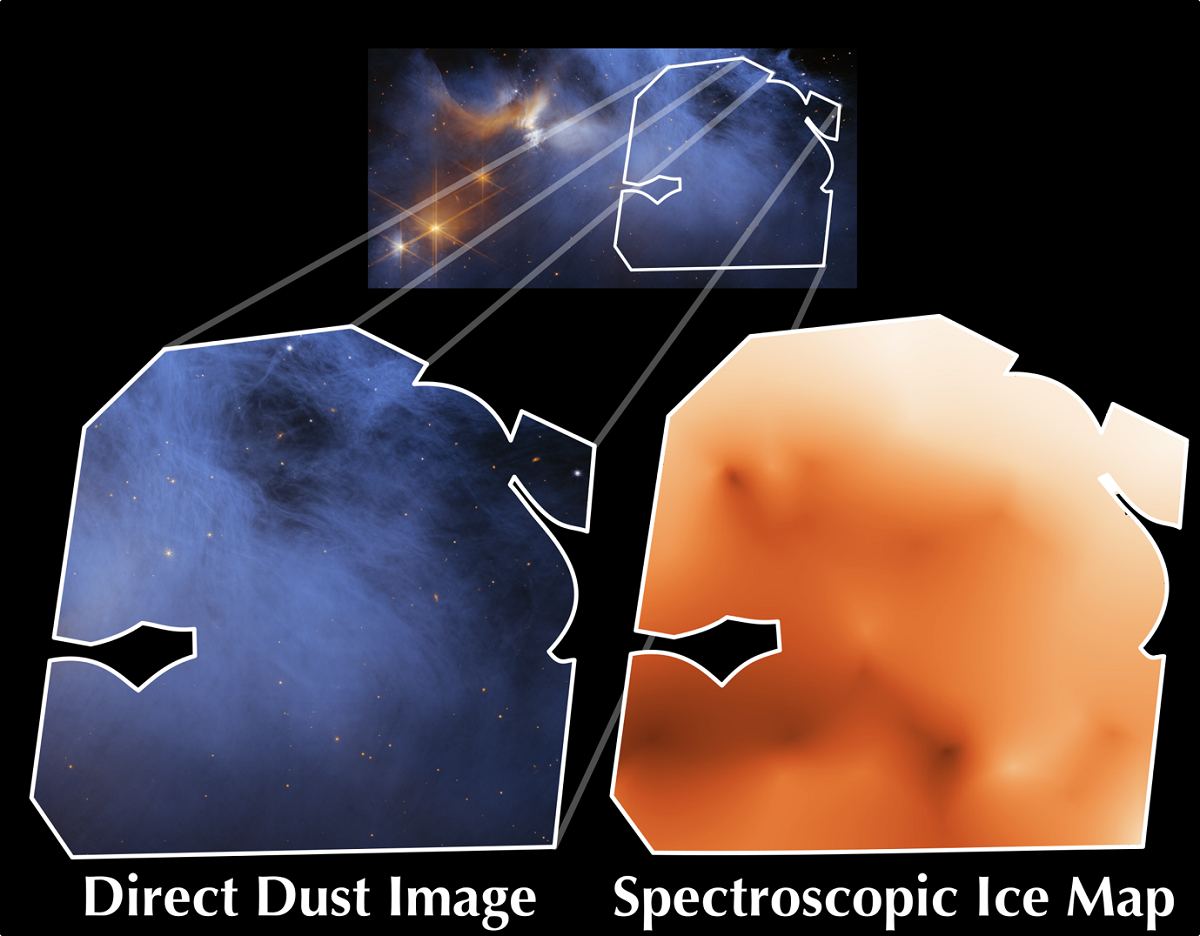OU News
News from The Open University
- Home
- OU researchers use specialised method to map ices across a molecular cloud with JWST
OU researchers use specialised method to map ices across a molecular cloud with JWST
Posted on • Science, maths, computing and technology

Research led by academics at the The Open University (OU) has used a specialised observing mode of the James Webb Space Telescope (JWST) to map interstellar ices containing water (H2O), carbon dioxide (CO2) and carbon monoxide (CO) simultaneously across a molecular cloud with an unprecedented level of resolution.
The study, published today in Nature Astronomy, has shown that high sensitivity JWST observations are required to reveal local variation of the ice molecular abundances within molecular clouds which question current ice formation assumptions.
The IceAge Early Release Science program, 1309, observed the ‘Chamaeleon I’ molecular cloud using an instrument named NIRCam Wide Field Slitless Spectroscopy to obtain spectra of tens of background stars in tandem, which contain the H2O, CO2 and CO ice absorption features superimposed onto them.
The depths of these absorption bands are used to measure the abundances of these icy molecules at a given position within Chamaeleon I. With the measured ice abundances and the corresponding locations of the cloud that were probed, maps of the ice distribution and variation across Chamaeleon I were made. These measurements were then used to infer chemical variations across the cloud through the comparison of the H2O, CO2 and CO abundances.
These ices are the key chemical precursors that will set the initial conditions for the chemistry of protoplanetary disks (a rotating disk of gas and dust surrounding a young star, from which planets form) and, ultimately, contribute to the potential habitability of the exoplanets that may form within a disk.
It is critical to finely map how this ice chemistry changes across the region of the molecular cloud which will collapse into the disk material. Despite the importance of this icy material, previous telescopes have not had the capabilities to fully survey these ices in the way this research has been able to.
In order to produce these maps, Dr. Zak Smith, Dr. Helen Fraser and Dr. Hugh Dickinson of the OU were leaders of the team that developed a custom piece of software to produce these maps. The mapping technique represents a step change in our ability to observe and detect ice in space, and is a novel (and currently under-exploited) use of the technical capabilities of the JWST.
Dr. Zak Smith, lead author of the paper, said:
“Retrieving the missing information from the ices is essential to understanding the initial chemical conditions from which stellar and planetary systems form. This research demonstrates the most thorough effort in doing this and our software will allow astronomers to continue collecting such important datasets in the future.”
In producing these maps, the team were able to show that the broad generalisations generated from previous observations – that where an increase in the dust content in a cloud is observed, one would expect the ice abundance to increase too – generally holds.
However, critically within Chamaeleon I, this work using JWST has revealed that this generalisation about ice formation must now be treated with caution when studying chemistry in molecular clouds, since local variations in ice abundances were observed. The JWST’s sensitivity has allowed researchers to map these ices on spatial scales previously unattainable and unlock this new phenomena.
This opens the question as to what is causing these variations. Mapping other clouds with the technique presented in this work may help to answer this. In the upcoming JWST Cycle 2 CHEERIO GO program 4358, led by Smith, the edge of the Chamaeleon I cloud will be mapped to search for the region where the initial formation of icy molecules, like water, occurs and whether these same local variations are observed.
More information
Read full article Cospatial ice mapping of H2O with CO2 and CO across a molecular cloud with JWST/NIRCam online.
Header image: © Z.L. Smith (Leiden University, Open University), J.A. Noble (CNRS), M.F Rashman (Open University) and the IceAge team. Image adapted from data presented in Smith et al. Nature Astronomy 2025 (doi: 10.1038/s41550-025-02511-z) and from a NIRCam image of Cha I (credit: NASA, ESA, CSA and M. Zamani (ESA/Webb); science: M.K. McClure. (Leiden University), F. Sun. (Steward Observatory), Z.L. Smith. (Open University) and the IceAge ERS team).